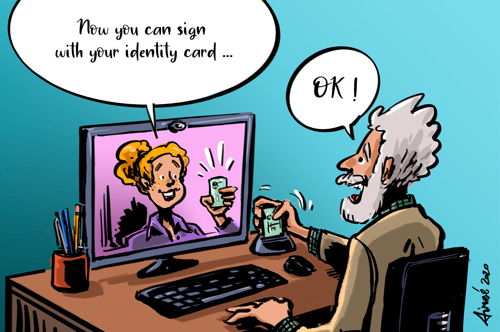- Commercial and Economic Law
- Tracy Enta - Ulrike Beuselinck
- corona , corona crisis , electronic signature , law of evidence , handwritten signature , signature
The corona crisis increases the importance of electronic signatures as parties are - in principle - not allowed to physically move around to sign documents.
1. There are several types of electronic signatures
Within the European Union, a regulation (e-IDAS regulation) has been in force since 2014 that makes it possible to sign documents electronically.
The e-IDAS regulation makes a distinction between three different types of electronic signatures, namely the ordinary, the advanced and the qualified electronic signature.
However, these do not all have the same (evidential) value:
- The ordinary electronic signature does not have to meet specific conditions.
Any electronic means of identification can be qualified as a plain electronic signature. One of the most common examples is the e-mail signature, the handwritten signature you add to a PDF document, a photo of your signature, etc. Any writing under which a signatory places an ordinary electronic signature constitutes a private deed and, at the same time, a valid legal act. - The advanced electronic signature has a higher level of security than the ordinary electronic signature. It makes it possible to trace the identity of the signatory and the content of the original signed document. In addition, this form makes any changes to the content traceable. The most common example is the token generated by your bank card when signing banking transactions.
- The qualified electronic signature offers the highest level of security and is the only form that is fully equivalent to a handwritten signature. This form offers more guarantees than previous forms, as a certification body intervenes to guarantee the link between the signature and the signatory. As a result, no problems can arise with regard to the identity of the signatory. Only entrepreneurs accredited by the Federal Public Service Economy (or a foreign inspection body) can offer signature software that complies with this standard. The signature with a Belgian e-ID or Itsme, are a few examples of this.
The Belgian legislator has also provided that, for a private deed, "a set of electronic data which can be attributed to a specific person and which demonstrates the preservation of the integrity of the content of the deed" is accepted as a signature.
As from 1 November 2020, the new law of evidence will also enter into force. It is very clear that the Belgian legislator has given the electronic signature a real facelift. The future law takes account of the fact that many transactions take place online and that, as a result, contracts/documents cannot always be drawn up in writing with a handwritten signature. Moreover, the electronic signature in this law will be better aligned with the European regulations. For more information about the new evidence law, we also refer to our earlier article on our website.

2. Which signature is now required?
Before you use an electronic signature, you should always keep in mind what the purpose of your signature is and what level of signature is actually required.
If your signature is used in the context of (ordinary) correspondence or has a solemn function, it is in principle not necessary to use an e-signature.
If your signature has to have a probative reason, an ordinary electronic signature is sufficient. This is, for example, the case when you want to counter-sign an offer, an order form, or a contract. If you believe that the legal act is important, you can also use a qualified signature. This signature has the same value as a handwritten signature.
But especially if your signature is a (legal) validity condition or a fundamental form requirement, you should opt for a qualified electronic signature as it offers the most guarantees.
3. Conclusion
When you want to sign a document electronically, first check the purpose of your electronic signature and whether there are any legal provisions that require a specific signature.
The most appropriate solution is still a handwritten signature or a qualified electronic signature.
If you need to sign a new document/contract with a person who does not have a qualified signature, it is important to build in additional guarantees (e.g. sharing scans of signed documents) in order to create mutual trust. For example, it is important to always be sure of the identity of the signatories.
For example, it is important to always be certain of the identity of the signatory and the fact that the content of the signed document remains unchanged after it has been signed.
If you already have an existing framework agreement with a co-contractor, it is best to check whether it is possible to enter changes and orders without using a handwritten signature (e.g. when the agreement allows parties to agree to changes on the basis of a simple letter/e-mail exchange). If such a system does not exist, it is advisable to offer or request additional guarantees, just as when concluding new agreements.
In short, the basic principle is always that there must be trust between the signatories. If you trust the other signatory, a simple exchange of e-mails or a scan of a signature in a PDF file will suffice. For more important contracts where you do not (yet) have a relationship of trust with the other party, it is best to obtain confirmation by means of a signature that offers sufficient guarantees, namely a handwritten signature or a qualified electronic signature.







